I lift a sandal on the back porch, and several insects go scurrying away. I pick lettuce leaves and more go tumbling out of the leaves. They’re everywhere this year: under the car, in house cracks, even in clothing. Earwigs.
When you’re looking, local nature always holds surprises. Seeing a new backyard bird or encountering something unexpected like mating snakes is always a delight. It might be a stretch to call an abundance of earwigs delightful. But even a pest species can hold surprises for a curious naturalist.
There are 2,000 species of earwigs worldwide, found on every continent except Antarctica. They make up the insect Order Dermaptera, and are characterized by wings they rarely use and the distinctive pincers that freak out so many people.
Earwigs have been the subject of folklore for centuries. The truth might be even more strange—and startling—than any tall tale. Read on for a look at earwig parenting, earwig love and the truth about earwigs in your ear. If you dare.
That Earwig in Your House
There are 10 native species of earwigs in the United States, and they’re benign or even helpful creatures. They eat vegetation as well as other insects. But it’s a non-native earwig, the European earwig (Forficula auricularia), that most of us in North America will encounter.
The European earwig is the one you often find scurrying around your basement or in your garden. This species was first documented in Seattle in 1907, and since then has thrived and spread across the continent.
It is considered a household and garden pest, although as invasive species go, the impacts are fairly mild given the abundance of the species. I know in our backyard garden many leaves are pockmarked from their feeding, and they can really hammer the raspberries. But they don’t have a major economic or ecological impact.
In fact, a Washington State University study found that European earwigs can even be beneficial. Researchers found they prey on aphids, significantly reducing damage in commercial apple orchards.
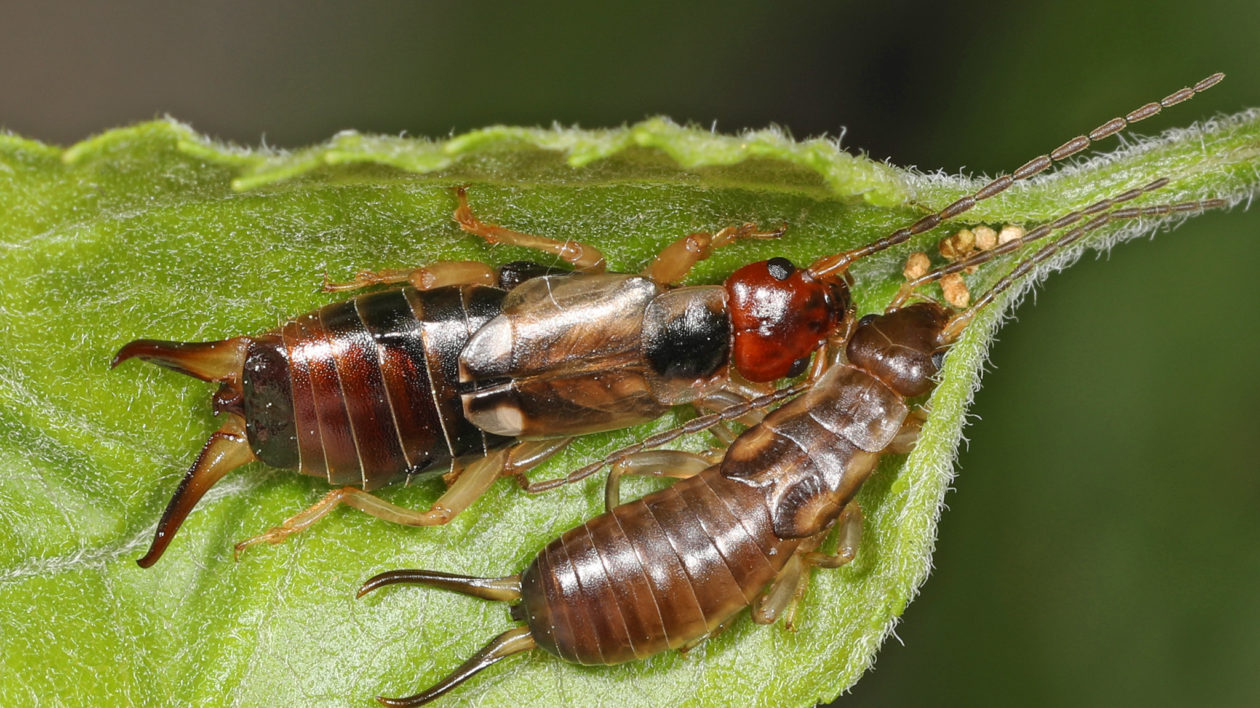
Excellent Mothers
Yes, those pincers are kind of creepy (more on them in a bit). And I admit, it’s difficult to find earwigs endearing. But consider this: they’re very protective and meticulous mothers.
It’s true—and very rare among insects (especially non-social insects). Mother earwigs carefully guard their eggs, tending them for weeks. They move their eggs to a safe spot. Researchers have tried putting small wax balls in their midst. The earwig will initially care for them, but the scent is wrong, so they are removed from the nest.
Earwigs also groom the eggs, removing potentially harmful fungi. A paper published in the journal Behavioral Ecology found that this grooming not only removes the fungi, but also applies a chemical to the egg’s surface that has anti-fungal properties.
This maternal care extends once the eggs are hatched. In some species, the mother continues to care for the earwig nymphs and supplies them with food, greatly increasing their chances of survival in the “outside world.” Most species stick with their mothers until they have molted twice. Every researched species of earwig has exhibited maternal care, according to the Journal of Insect Science, although the methods and level of care vary. And one species takes it to an extreme…
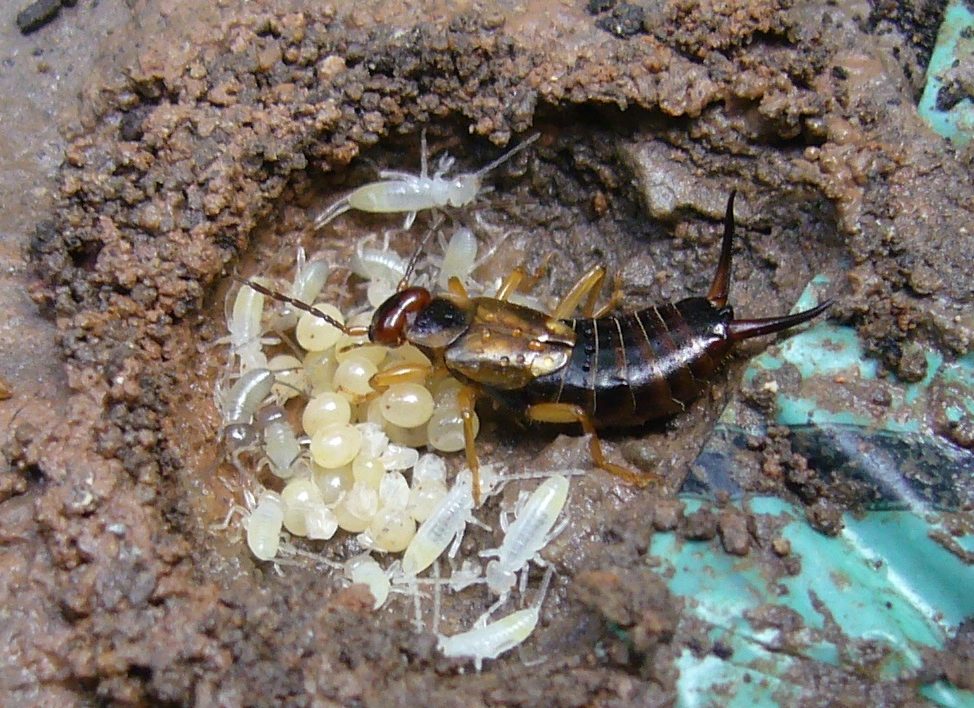
Eating Mom
Females of the hump earwig guard their young until they are old enough to take care of themselves. Anthropomorphically, we might imagine some sense of gratitude, perhaps an insect version of a hug or Mother’s Day card. Nope. Young hump earwigs get ready to leave the nest by turning mom into dinner. This practice of eating one’s mother, practiced by other insects as well, is called matriphagy.
From an insect’s point of view, this strategy makes sense. The mother is a ready source of calories, and even better the young earwigs don’t have to leave the safety of the nest to dine. A paper published in the Journal of Ethology demonstrated that this provisioning, as the researchers put it, leads to increased survival once the earwigs depart. Mom pays the ultimate price, but the next generation is fat and healthy when they face the harsh world outside the nest.
Earwig Love
Earwig courtship is reported to be a rather involved affair, and includes use of the pincers. According to the Living with Insects blog, males use their pincers (called cerci) to compete over females.
As the author notes:
“The male courts a female by tapping and stroking a female on the abdomen with his forceps and presenting them to the female. Females nibble the forceps, presumably receiving some chemosensory input to help them decide.”
Male earwigs have supersized genitalia, called virga. In some species, the rod-like virga is as long as the male’s body length, and twice as long as the female’s. Research by Yoshitaka Kamimura of the Tokyo Metropolitan University suggested that these elongated virga may do more than inseminate. When the male extracts the virga, which in one species contains a “brim like tip”, it may clean out sperm from other males that have previously mated with the female.
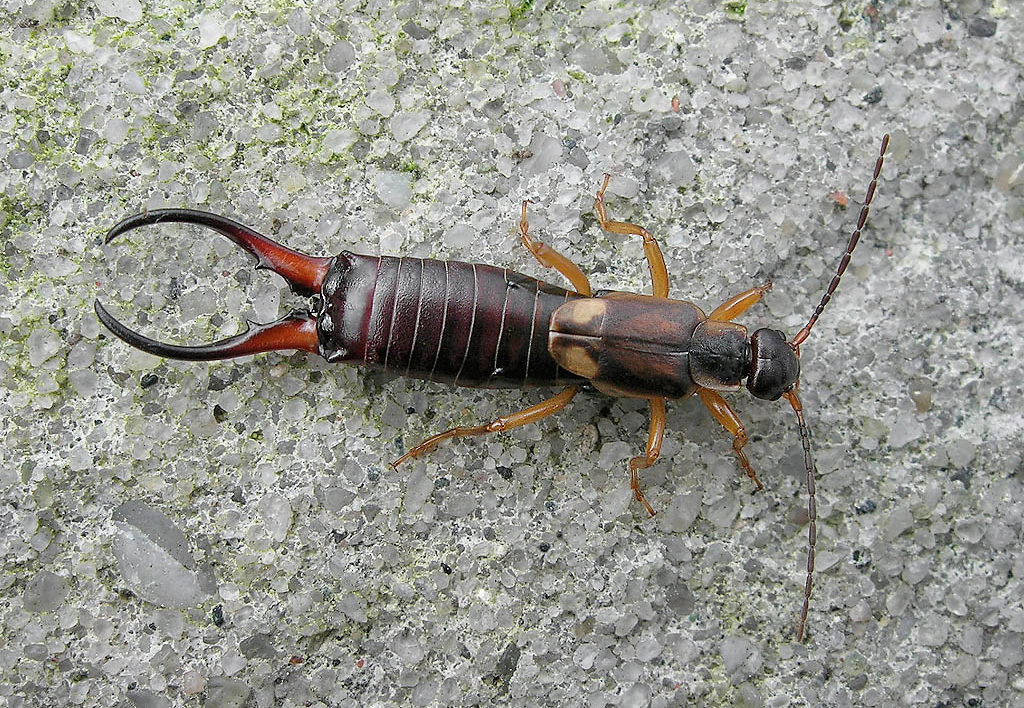
About those Pincers
Earwigs are not unattractive insects (they’re really not, look closely). But those pincers. It makes them look more frightening than they really are. In truth, the pincers of the common European earwig do little damage. I have picked up hundreds of them this summer; my backyard chickens find them to be a tasty snack. While I’ve been pinched repeatedly, I have never felt the slightest bit of pain.
The pincers, called cerci, are notably curved in males and straight in females. As noted previously, they can be used in courtship, both to battle opposing males and also to grasp a female while mating.
Scent of an Earwig
While the pincers may not bother you, the earwig’s scent is truly objectionable. Not all earwigs do this, but some emit a foul-smelling liquid as a defensive strategy. When I pick up the local earwigs, I notice an acrid smell on my fingers, not unlike a bad battery. The chickens don’t seem to mind.
This may be just one of the reasons vineyards don’t want earwigs around. Research found that 10 or more earwigs per kilogram imparted a significant taste to the wine.
The same paper also found that earwig feces also affect wine quality. As reported in the Living with Insects blog, “as little as 0.6 g of earwig feces per kilogram produce an off flavor variably described as ‘animal, ‘reductive’, “vegetal”, ‘acidic’, ‘bitter’ and ‘tannic’.”
If you have not already noticed, earwig research is a very, very strange field.
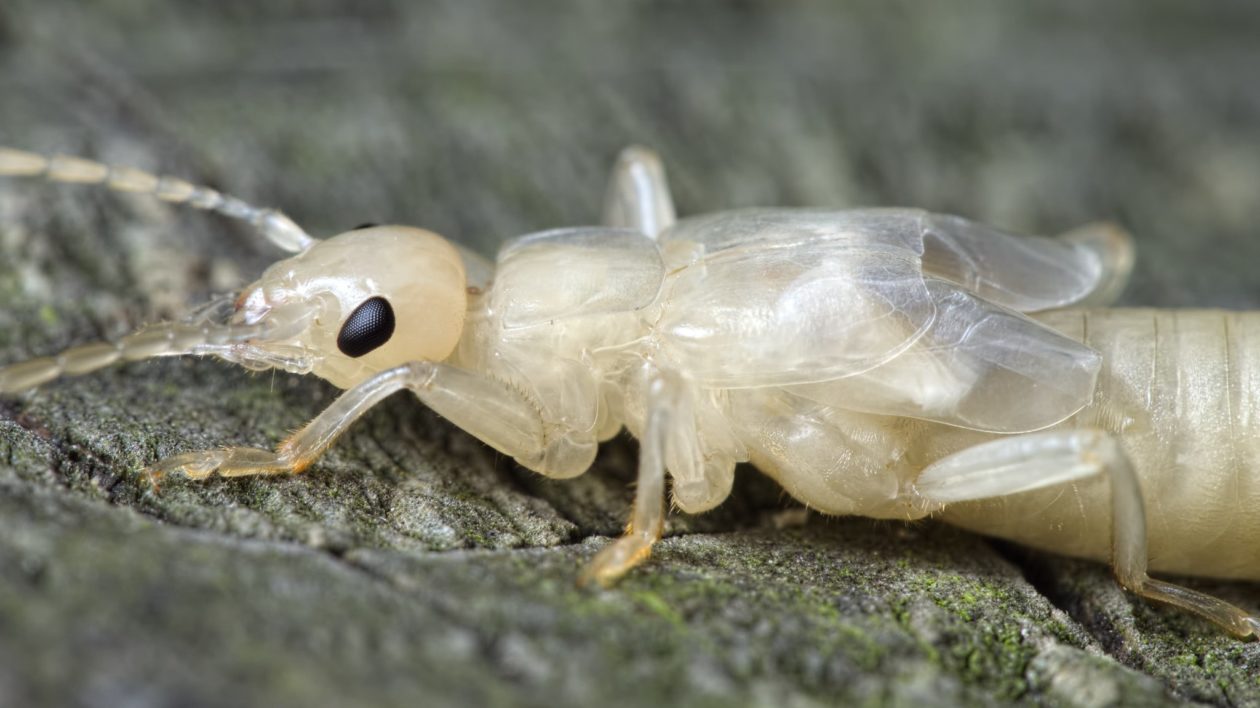
The Giant Earwig
The giant earwig (also known as the St. Helena earwig) was the largest of all, reaching more than three inches in length—including very formidable pincers.
This earwig was found only on the small St. Helena Island in the Atlantic. It was a textbook example of the well-documented evolutionary trend where some species become super-sized on islands. It also, sadly, is a textbook example of the vulnerability of island wildlife.
The giant earwig has not been found alive since 1967. As is the case with many insects, its decline and eventual disappearance were scarcely noted. But the reasons appear to be the usual list that cause island species to disappear: invasive predators, loss of habitat and possibly even collection of the stones that offered earwig hiding spots.
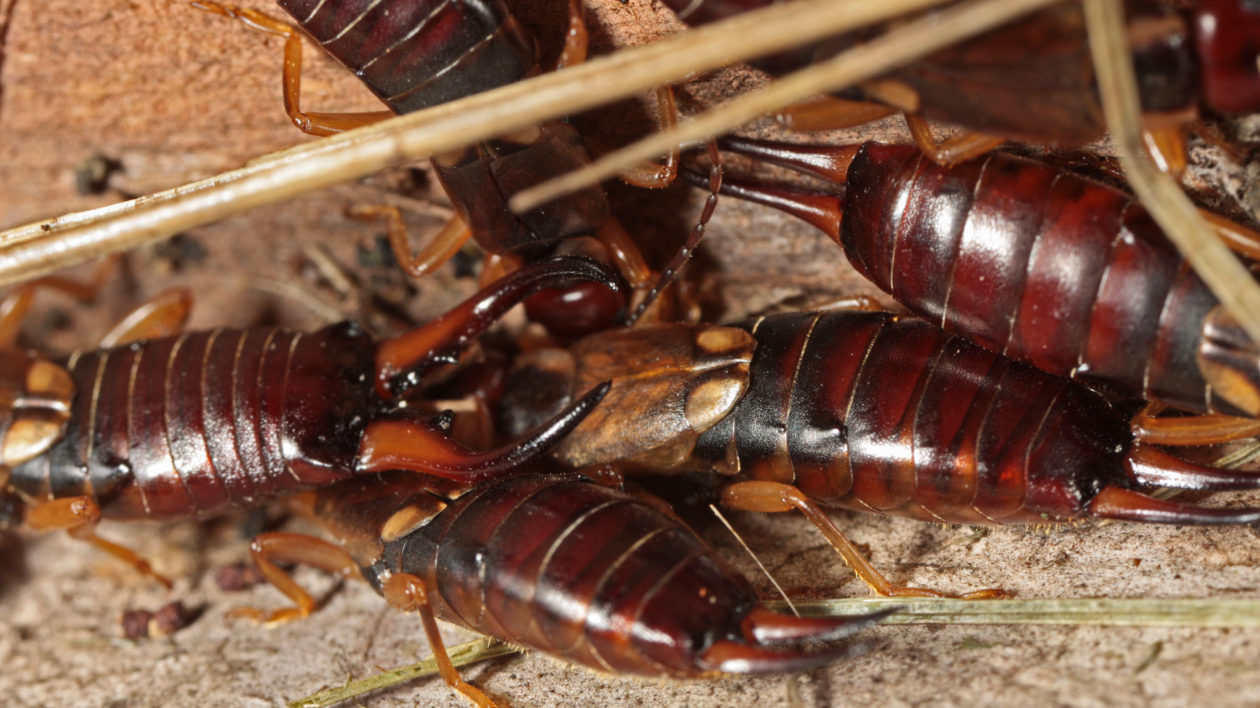
The Earwig in Your Ear
There is no shortage of theories as to the origin of the earwig’s name. “Ear” is a part of this insect’s common name in several languages. Some have suggested the pincers make them look like earrings, and others that their wings resemble ears. But it seems most likely this ties to a bit of folklore: the old story goes that insects climb into the ear, and then burrow into the brain. Where they lay eggs and/or cause insanity.
Hopefully, I don’t have to state that earwigs don’t burrow into brains. And, as many sources note, earwigs are unlikely to climb into your ear. However, “unlikely” is different from “never.”
Earwigs are nocturnal. They take refuge in cozy, dark environments, like building cracks, lettuce leaves, and under shoes. Would an ear make a nice refuge if an earwig stumbled across it? Perhaps.
In fact, numerous reports—some published in the scientific literature—verify that this horror does indeed happen.
A letter in the Western Journal of Medicine provides details of one found in the ear of the author’s daughter, initially thought to be a dirty chunk of ear wax. As the letter details: “My brief discussion with her on the importance of proper hygiene was interrupted when I saw the form move. Then, bathed in brilliant illumination from the otoscope, a female earwig…cautiously emerged, to the relief of insect, child and father.”
The letter details other incidents in which earwigs were indeed found in ears. Some reports claim the pincers can pierce the ear drum. Whatever the case, having a large insect in one’s ear cannot be a pleasant experience. A nightmarish version of this scenario was even explored in a horror episode by Rod Serling, of Twilight Zone fame.
While I don’t really enjoy earwigs in the garden, it’s undoubtedly better than in my ear. And I have to admit, the research (unusual as it may be) gives me new respect for these insects. Take a closer look, and even household pests are fascinating creatures.
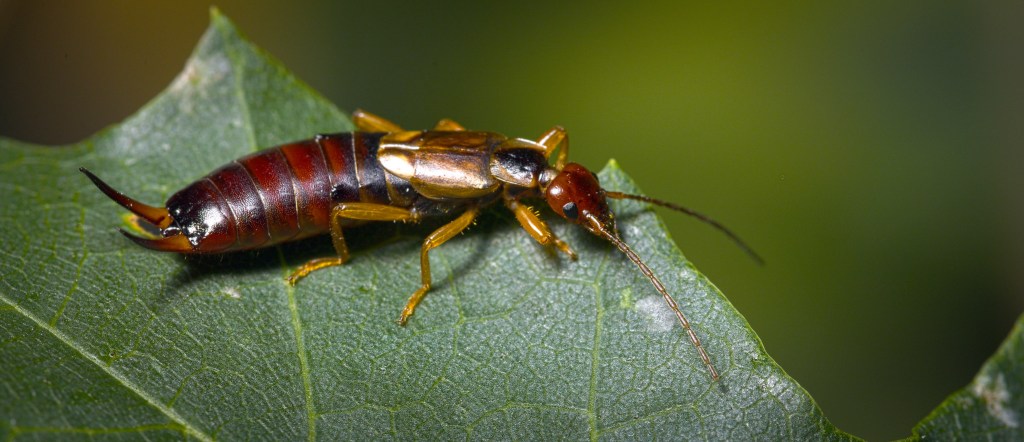



Thank you for this article. When googling earwigs you will find article after article about how to rid your house of them. Being a lover of all insects I wanted to find the positives in them. You did just that! I will now grace my family wonderful earwig facts that they will yawn at while I smile and keep talking, haha. Thanks again!
Awesome article, above and beyond typical blog quality. Loved the links to the various unusual earwig research you came across. Thanks
Very helpful.it help me understand them better
Thank you for the info and illustrations. I found it most interesting. I only looked it up after finding one in the bottom of the bath. It has been years since I’ve seen one so thought I would research facts about them. Glad to hear they like to eat aphids.
I found a black earwig in my house in eastern province in Saudi Arabia , I have no idea if it is originally from this area or came from another country, do you have any idea?
Thanks…
THANK YOU for your research. Extremely informative and helpful.
We moved to Conway SC Oct. of ’20 and although there has been NO shortage of insect/reptilian encounters, (which the Realtor conveniently left out) I would say keeping the EARWIGS out of the house and garden is the most dauting task!
What is the most effective way to either deter or terminate them, please?
The question was not answered, can they go in reverse? Backup? I have only seen them pivot 360 degrees.
Ha! As I came across this post and saw the earwig I called to my husband, (his name is Matthew Miller, by the way) and his response was (without knowing I called to him about earwigs) “Hey, there’s a giant earwig on our screen door!” … They ARE everywhere this summer! I had to replant and protect our plant starts this spring just to evade the invasion!
Interesting facts regarding the species, and actual earwigging little critters! EW!
Thanks so much!
Janice Miller
I’ve said before that we judge earwigs by the typical criteria — looks — and gasp in horror at the sight. Yet we’ll let a firefly with its twinkling magic crawl all over our hand. I’ll try to remember after this that earwigs are outstanding mothers. 🙂
Great article. However, I would have to disagree with the pinch not hurting. My experience was much different when I felt a sharp pain on my ankle.. looked down and it was one of these little critters!
Hi Tracy,
Thanks for writing. My spouse said the same thing when she read it…she has had several that have pinched her hard.
This was a wonderful report about one of the most detested insects. Very interesting .
Thank you for all your work & sharing the results
Typo: “as little as 0.6 kg of earwig feces per kilogram”. That’s 60% by weight. Maybe it should be 0.6 g/Kg?
Good article otherwise. I remember as a kid dreading that an earwig would crawl into my ear at night.
Thanks. You are correct and it is corrected now. Glad you liked the article.
Thanks again for an outstanding piece f research on a much maligned insect. In your research did you come across anything about large swarms in late Spring or early summer. Every year in May and June at a local State Park (Mount Diablo State Park CA.) we have hundreds of European ear wigs flying, crawling, and scurrying around the Summit visitors center; 3850 feet. I have tried to research this phenomenon too no avail. It always surprises (or freaks out) visitors to find out that they can fly and its not unusual for several to land on an individual. I wonder if this is part of a mating ritual. I have yet to see any kind of mating activity but it may occur at nigh. These critters do get into everything and anything at this time.
Indeed, I found a small earwig (3/4 inch) on my pillow last month in an otherwise very clean bedroom in my house in Denver. Not having previously read your fascinating article, and not wanting an ear earwig, I quickly dispatched it. I regret not having studied it more closely to determine its sex, but I was more concerned about its reason for being there. They are fairly infrequent visitors in my house.
Great article! I look forward to sharing this information with my granddaughter, who loves bugs of all kinds. I will show her how to tell the difference between male and female, and will tell her what wonderful mothers the females are. I will also inform her that the pincers don’t hurt if you happen to get pinched, so no need to be afraid of them. I enjoyed this read very much. Thank you!